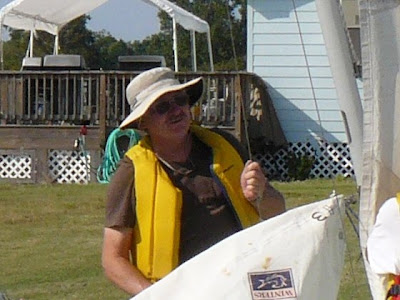
The coaches are a KEY part of this sailing program. When school is on break, or the sailing squad is inactive, we coaches keep busy year round.
Head Coach Rezab (pointing, on left) and Coach Hittner (standing, on right) give close & careful attention to every sail ;
Here are some photos & a brief biography of some of our sailing coaches. We should keep in mind that all are volunteers.
 Head Sailing Coach Jerry Rezab
Head Sailing Coach Jerry RezabResident of Fairfield Harbour, Coach Rezab is a member of Blackbeard Sailing Club and Fairfield Harbour Yacht Club. He began sailing by racing in Windmill class boats, and has continued to sail these favorites while also sailing & racing 30+ ft keelboats.
His impressive knowledge is more than matched by his enthusiasm and energy. Jerry came to New Bern from the Chicago area.
Photo at left shows Head Coach Rezab working on the NJROTC "float" for the 2010 Christmas Parade
Joe is a member of the Fairfield Harbour Yacht Club and has been involved with the New Bern NJROTC sailing program since its inception. Joe has over 30 years of sailing experience both in cruising and racing keel boats, having cruised and lived aboard his own boats from the Florida Keys to Canadian waters.
Coach Gormley sailing in Maine

A former micro-electronics engineer hailing from New England's home waters of Buzzards Bay and Narragansett Bay, Joe along with his first mate Kathy moved to New Bern in 2002.
.Coach Gormley on the beach at Hattaras Island
.

Douglas King is originally from Havelock, is a Navy veteran, and alumnus of New Bern High and later of N.C. State University. His whole family has "always sailed" and he has 5 decades sailing experience, having begun as a toddler. He is a US Sailing Level 1 certified instructor.
Here is Coach King on a chartered cruiser in the Caribbean
Mr. King is a retired engineer who returned to New Bern with his wife. She is also an enthusiastic sailor & cruiser (link to their Great Loop voyage) and they live in Fairfield Harbour.
 Coach King's theory is that sailing is easy... if he can do it, anybody can! He has been a volunteer sailing coach since 2009, and has worked hard at developing the cadet sailor's booklet and the other teaching materials.
Coach King's theory is that sailing is easy... if he can do it, anybody can! He has been a volunteer sailing coach since 2009, and has worked hard at developing the cadet sailor's booklet and the other teaching materials.An historic photo of Coach King without a wide-brim hat. It must have blown off during this race. The pretty girl trimming the spinnaker is his wife Kathie.
.
.
.
 Coach Murphy formerly taught sailing to adults with the Sailing Club of Washington. He was also a volunteer instructor for an after-school sailing program. He owns a Montgomery 15 micro cruiser that he uses to explore the local creeks, rivers, and sounds. He also uses it to explore further afield by trailering to more distant waters.
Coach Murphy formerly taught sailing to adults with the Sailing Club of Washington. He was also a volunteer instructor for an after-school sailing program. He owns a Montgomery 15 micro cruiser that he uses to explore the local creeks, rivers, and sounds. He also uses it to explore further afield by trailering to more distant waters.Coach Murphy stopping traffic, going for a sail on the Neuse...
He is a retired Forest Ranger who spent most of his career in the Mountain West. He and his wife moved to New Bern two and a half years ago because of the sense of community offered by New Bern, the friendly people, and the opportunity for local sailing. They have three daughters. One lives in California where she teaches High School Science, another daughter lives in Japan with her husband who is with the Air Force, and their youngest is a Doctor working in Kentucky.
.
.

Coach Murphy preparing to explore the Bay River
Coach Murphy is one of our on-the-water sailing teachers. He is also in charge of fleet maintenance. He joined the NJROTC program in 2010 and is looking forward to a great sailing season with the cadets.
.
 Coach Jackson is a member of Fairfield Harbour Yacht Club. He began sailing on Lake Superior, and found New Bern while cruising south with his familiy. They liked it so much that they moved here... in fact the boat liked it too, and has never returned to Lake Superior since then!
Coach Jackson is a member of Fairfield Harbour Yacht Club. He began sailing on Lake Superior, and found New Bern while cruising south with his familiy. They liked it so much that they moved here... in fact the boat liked it too, and has never returned to Lake Superior since then!(photo at right) Coach Jackson in his hat & shades watching NJROTC cadets practicing FJ capsizes in his swimming pool
Mr. Jackson volunteered to become on of our coaches in 2010. He is also a lifeguard at the Twin Rivers YMCA in New Bern, which how he passes the time when he's not cruising or racing on the Neuse River. His knowledge ON or IN the water is valuable to our program.
.

Coach O'Flanagan lives in Fairfield Harbour, where he keeps his cruising boat named 'The Balance.'
Our other volunteers & coaches should definitely be recognized, we will have pictures & short bios posted as soon as possible.
Mark Hittner...
Bill Jarvis...
Don Harris...
Herm Schiller
Tom Wynn...
Buddy Dillinger...
Bud Ellis...
Brett Mozingo...
Al Muenster...
Ed Klebauer...
Bob Petritsch...
Larry Rotta, Head Sailing Coach from 2003 to 2006...
... ... posted by Assistant Coach Douglas King








